#Traditional Knowledge
Text
In the Willamette Valley of Oregon, the long study of a butterfly once thought extinct has led to a chain reaction of conservation in a long-cultivated region.
The conservation work, along with helping other species, has been so successful that the Fender’s blue butterfly is slated to be downlisted from Endangered to Threatened on the Endangered Species List—only the second time an insect has made such a recovery.
[Note: "the second time" is as of the article publication in November 2022.]
To live out its nectar-drinking existence in the upland prairie ecosystem in northwest Oregon, Fender’s blue relies on the help of other species, including humans, but also ants, and a particular species of lupine.
After Fender’s blue was rediscovered in the 1980s, 50 years after being declared extinct, scientists realized that the net had to be cast wide to ensure its continued survival; work which is now restoring these upland ecosystems to their pre-colonial state, welcoming indigenous knowledge back onto the land, and spreading the Kincaid lupine around the Willamette Valley.
First collected in 1929 [more like "first formally documented by Western scientists"], Fender’s blue disappeared for decades. By the time it was rediscovered only 3,400 or so were estimated to exist, while much of the Willamette Valley that was its home had been turned over to farming on the lowland prairie, and grazing on the slopes and buttes.
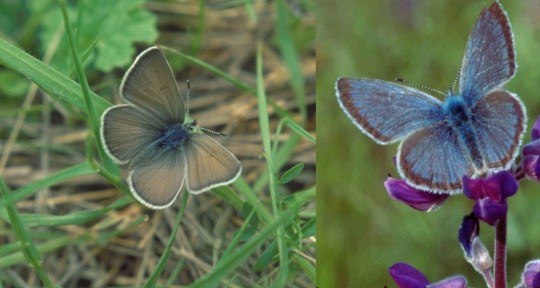
Pictured: Female and male Fender’s blue butterflies.
Now its numbers have quadrupled, largely due to a recovery plan enacted by the Fish and Wildlife Service that targeted the revival at scale of Kincaid’s lupine, a perennial flower of equal rarity. Grown en-masse by inmates of correctional facility programs that teach green-thumb skills for when they rejoin society, these finicky flowers have also exploded in numbers.
[Note: Okay, I looked it up, and this is NOT a new kind of shitty greenwashing prison labor. This is in partnership with the Sustainability in Prisons Project, which honestly sounds like pretty good/genuine organization/program to me. These programs specifically offer incarcerated people college credits and professional training/certifications, and many of the courses are written and/or taught by incarcerated individuals, in addition to the substantial mental health benefits (see x, x, x) associated with contact with nature.]
The lupines needed the kind of upland prairie that’s now hard to find in the valley where they once flourished because of the native Kalapuya people’s regular cultural burning of the meadows.
While it sounds counterintuitive to burn a meadow to increase numbers of flowers and butterflies, grasses and forbs [a.k.a. herbs] become too dense in the absence of such disturbances, while their fine soil building eventually creates ideal terrain for woody shrubs, trees, and thus the end of the grassland altogether.
Fender’s blue caterpillars produce a little bit of nectar, which nearby ants eat. This has led over evolutionary time to a co-dependent relationship, where the ants actively protect the caterpillars. High grasses and woody shrubs however prevent the ants from finding the caterpillars, who are then preyed on by other insects.
Now the Confederated Tribes of Grand Ronde are being welcomed back onto these prairie landscapes to apply their [traditional burning practices], after the FWS discovered that actively managing the grasslands by removing invasive species and keeping the grass short allowed the lupines to flourish.
By restoring the lupines with sweat and fire, the butterflies have returned. There are now more than 10,000 found on the buttes of the Willamette Valley."
-via Good News Network, November 28, 2022
#butterflies#butterfly#endangered species#conservation#ecosystem restoration#ecosystem#ecology#environment#older news but still v relevant!#fire#fire ecology#indigenous#traditional knowledge#indigenous knowledge#lupine#wild flowers#plants#botany#lepidoptera#lepidopterology#entomology#insects#good news#hope
4K notes
·
View notes
Text
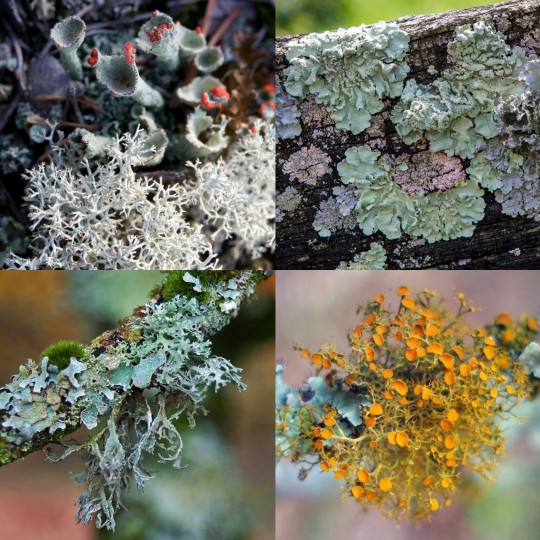
"I once heard a Navajo herbalist explain how she understands certain kinds of plants to be "married", due to their enduring partnership and unquestioning reliance on one another.
Lichens are a couple in which the whole is more than the sum of it's parts ... a marriage in which the balance of giving and taking is dynamic, the roles of giver and receiver shifting from moment to moment.
They are committed to an "us" that emerges from the shared strengths and weaknesses of the partners, an "us" that extends beyond the boundaries of coupledom and into their family and community ... their shared lives benefit the whole ecosystem."
-Robin Wall Kimmerer, Braiding Sweetgrass, p. 212
#braiding sweetgrass#robin wall kimmerer#lichen#lichen love#ecology#traditional knowledge#TK#indigenous authors#solarpunk#cottagecore
427 notes
·
View notes
Text
South African researcher on the management of communal land
By
Wonga Masiza
Researcher, Agricultural Research Council
To understand the extent, causes and impact of communal land change, we analysed a series of historical satellite images from 1989 to 2019 and conducted interviews with locals. Instead of interviewing experts and leaders, the study measured the most common perceptions among community members.
As far as we know, this study is one of the first in South Africa to combine satellite data and local perceptions. This offered a more complete view of communal land change, and valuable insights on its impacts.
We suggested some ways in which this land could be managed better to provide ecosystem services and livelihoods.
Snippet
Satellite imagery from 1989 to 2019 revealed increases of the sweet thorn tree (Vachellia karroo) by 25% and the residential area (2.5%). It showed declines of grazing land (18%), cropland (9.6%) and dams (1.1%).
The land can be better managed through interventions by village committees, tribal authorities and extension services, and by following spatial planning and land use guidelines..
Most respondents (over 80%) noted the encroachment of the sweet thorn tree on grazing land and abandoned cropland. They said contributing factors were a decrease in fuelwood harvesting due to increased reliance on electricity, the abandonment of cropland (providing habitat for the sweet thorn) and seed dispersal caused by unrestricted movement of animals. Many saw the tree as beneficial because goats like to eat it and it makes good fuel. Others were concerned that this tree was invading productive agricultural land and causing a loss of biodiversity. They mentioned increased scarcity and disappearance of medicinal and culturally significant plants.
#local knowledge#traditional knowledge#endemic knowledge#indigenous knowledge#land management#communal land#south africa#managing land that belongs to everyone
2 notes
·
View notes
Text

"I acknowledge indigenous Australian’s connection to land and their sovereignty. I pay respect to the old stories of the land on which I live and work.
The indigenous people of the world hold the old stories, as they are embedded in their traditional knowledge.
Let’s look after the old stories. We need them more than ever."
OUR CAMPAIGN FOR A REFERENDUM ON AN INDIGENOUS CONSTITUTIONAL RECOGNITION THROUGH A VOICE TO PARLIAMENT NOW HAS A DESTINATION.
ALL AUSTRALIANS CAN BE INVOLVED IN THE JOURNEY.
You can find out more here:
https://fromtheheart.com.au/

#indigenous Australians#connection#land#sovereignty#On Country#indigenous people#traditional knowledge#old stories#Uluru Dialogue#The Uluru Statement#First Nations Voice#Uluru Statement From The Heart#First Nations Voice To Parliament#From The Heart#Makarrata Commission#treaty-making#truth-telling#history#Referendum 2023
22 notes
·
View notes
Text
youtube
Medicines and cosmetics use substances derived from nature. But Bioprospecting can turn into biopiracy. More and more companies are patenting natural ingredients making billions. It can come at a cost to the environment and traditional communities living in biodiversity-rich regions.
Credits:
Reporter: Louise Osborne
Video Editor: David Jacobi
Supervising Editor: Joanna Gottschalk
We're destroying our environment at an alarming rate. But it doesn't need to be this way. Our new channel Planet A explores the shift towards an eco-friendly world — and challenges our ideas about what dealing with climate change means. We look at the big and the small: What we can do and how the system needs to change. Every Friday we'll take a truly global look at how to get us out of this mess.
#PlanetA #Biopiracy #Colonialism
Read more:
European Patent Office accepts biopiracy argument and revokes patent: https://cordis.europa.eu/article/id/2...
World Intellectual Property Organization: Leveraging economic growth through benefit sharing: https://www.wipo.int/ipadvantage/en/d...
The Nagoya Protocol on access and benefit sharing: https://www.cbd.int/abs/
Corporate control and global governance of marine genetic resources: https://www.science.org/doi/10.1126/s...
Traditional Knowledge Digital Library: http://www.tkdl.res.in/tkdl/langdefau...
Chapters
00:00 Introduction
00:45 How It Began
02:28 Patently Questionable
05:25 Exploitation of Nature
07:12 Ethical Biotrade
08:38 Taking to the High Seas
10:50 The Road Ahead
#dw planet a#solarpunk#colonialism#nature#plants#Bioprospecting#biopiracy#companies#environment#indigenous people#Traditional Knowledge#capitalism#daniel robinson#Youtube
17 notes
·
View notes
Text
It is important that scientists working in chaos theory, biodiversity/Gaia studies, and post-Darwinian evolution acknowledge their genuine affinities with indigenous perspectives.
"Biological Exuberance: Animal Homosexuality and Natural Diversity" - Bruce Bagemihl
#book quote#biological exuberance#bruce bagemihl#nonfiction#scientists#chaos theory#biodiversity#gaia theory#gaia hypothesis#post darwinian evolution#indigenous knowledge#traditional knowledge
3 notes
·
View notes
Text
The fact is that two-spiritedness, homosexuality, bisexuality, and transgender are at the forefront of some of the most significant scientific re-visionings of our time – in which the gap between indigenous and Western perspectives is finally being bridged – yet their contribution is rarely, if ever, acknowledged by Western scientists. When prominent chaos theoreticians, biodiversity experts, and post-Darwinian evolutionists invoke the teachings of tribal peoples, they are usually unaware of the pivotal role played by homosexuality and transgender in these indigenous belief systems, or in the lives of the writers, storytellers, and visionaries who give poetic voice to their scientific concepts.
"Biological Exuberance: Animal Homosexuality and Natural Diversity" - Bruce Bagemihl
#book quote#biological exuberance#bruce bagemihl#nonfiction#two spirit#homosexuality#gay#lesbian#bisexual#transgender#forefront#indigenous knowledge#traditional knowledge#western science#chaos theory#biodiversity#post darwinian evolution#acknowledgment
2 notes
·
View notes
Text
Using Whakapapa in Materials Development: Practical Tips for Inspiring Learning Designers
Discover how to incorporate the Maori concept of whakapapa into your learning materials with these practical tips for learning designers. Enhance cultural understanding and engage learners with storytelling, case studies, and more. #whakapapa
What about using Whakapapa if you are a materials writer and or learning designer?
Not everyone is in the classroom. If your focus is on materials development and you’re looking for ways of using whakapapa in your content then consider these ideas below.
Use storytelling to explain the history and context of subject matter
Incorporate the concept of whakapapa into the learning design by using…

View On WordPress
#case studies#cultural context#cultural identity#Graeme Smith#learning design#Maori culture#materials development#storytelling#thisisgraeme#traditional knowledge#vocational education#whakapapa
2 notes
·
View notes
Text
2 notes
·
View notes
Text
Indigenous Knowledge Advancing the 2030 Agenda (UNPFII Side Event).
Indigenous languages are a vehicle for the inter-generational transmission of the IK. As part of the International Decade of Indigenous Languages 2022-2032, we must examine opportunities to promote, preserve and revitalize these languages.
This side event aims to illustrate how Indigenous Knowledges (IK) are transmitted, their contributions to a sustainable development, and their mobilization for the implementation of the Sustainable Development Goals, the International Decade on Indigenous Languages 2022-2032, and ultimately the United Nations Declaration on the Rights of Indigenous Peoples (UNDRIP).
Related Sites and Documents
Concept Note

Watch the Indigenous Knowledges Advancing the 2030 Agenda (UNPFII Side Event)
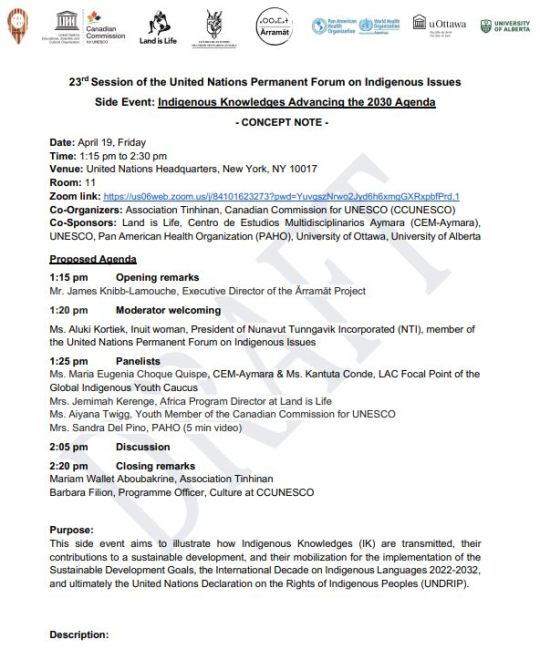

#unfpii23#international decades#UNDRIP#indigenous languages#side-events#agenda 2030#International Decade on Indigenous Languages 2022-2032#Indigenous Knowledges#Knowledge transmission#traditional knowledge#inter-generational
0 notes
Text
"In response to last year’s record-breaking heat due to El Niño and impacts from climate change, Indigenous Zenù farmers in Colombia are trying to revive the cultivation of traditional climate-resilient seeds and agroecology systems.
One traditional farming system combines farming with fishing: locals fish during the rainy season when water levels are high, and farm during the dry season on the fertile soils left by the receding water.
Locals and ecologists say conflicts over land with surrounding plantation owners, cattle ranchers and mines are also worsening the impacts of the climate crisis.
To protect their land, the Zenù reserve, which is today surrounded by monoculture plantations, was in 2005 declared the first Colombian territory free from GMOs.
...
In the Zenù reserve, issues with the weather, climate or soil are spread by word of mouth between farmers, or on La Positiva 103.0, a community agroecology radio station. And what’s been on every farmer’s mind is last year’s record-breaking heat and droughts. Both of these were charged by the twin impacts of climate change and a newly developing El Niño, a naturally occurring warmer period that last occurred here in 2016, say climate scientists.
Experts from Colombia’s Institute of Hydrology, Meteorology and Environmental Studies say the impacts of El Niño will be felt in Colombia until April 2024, adding to farmers’ concerns. Other scientists forecast June to August may be even hotter than 2023, and the next five years could be the hottest on record. On Jan. 24, President Gustavo Petro said he will declare wildfires a natural disaster, following an increase in forest fires that scientists attribute to the effects of El Niño.
In the face of these changes, Zenù farmers are trying to revive traditional agricultural practices like ancestral seed conservation and a unique agroecology system.
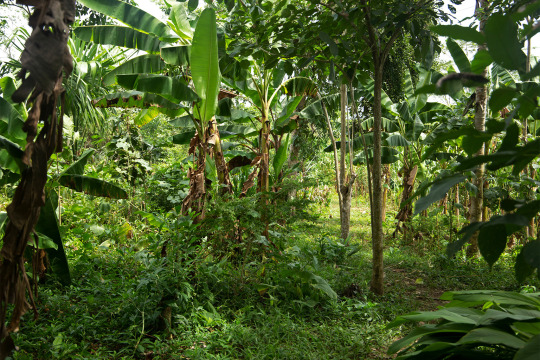
Pictured: Remberto Gil’s house is surrounded by an agroforestry system where turkeys and other animals graze under fruit trees such as maracuyá (Passiflora edulis), papaya (Carica papaya) and banana (Musa acuminata colla). Medicinal herbs like toronjil (Melissa officinalis) and tres bolas (Leonotis nepetifolia), and bushes like ají (Capsicum baccatum), yam and frijol diablito (beans) are part of the undergrowth. Image by Monica Pelliccia for Mongabay.
“Climate change is scary due to the possibility of food scarcity,” says Rodrigo Hernandez, a local authority with the Santa Isabel community. “Our ancestral seeds offer a solution as more resistant to climate change.”
Based on their experience, farmers say their ancestral seed varieties are more resistant to high temperatures compared to the imported varieties and cultivars they currently use. These ancestral varieties have adapted to the region’s ecosystem and require less water, they tell Mongabay. According to a report by local organization Grupo Semillas and development foundation SWISSAID, indigenous corn varieties like blaquito are more resistant to the heat, cariaco tolerates drought easily, and negrito is very resistant to high temperatures.
The Zenù diet still incorporates the traditional diversity of seeds, plant varieties and animals they consume, though they too are threatened by climate change: from fish recipes made from bocachico (Prochilodus magdalenae), and reptiles like the babilla or spectacled caiman (Caiman crocodilus), to different corn varieties to prepare arepas (cornmeal cakes), liquor, cheeses and soups.
“The most important challenge we have now is to save ancient species and involve new generations in ancestral practice,” says Sonia Rocha Marquez, a professor of social sciences at Sinù University in the city of Montería.
...[Despite] land scarcity, Negrete says communities are developing important projects to protect their traditional food systems. Farmers and seed custodians, like Gil, are working with the Association of Organic Agriculture and Livestock Producers (ASPROAL) and their Communitarian Seed House (Casa Comunitaria de Semillas Criollas y Nativas)...
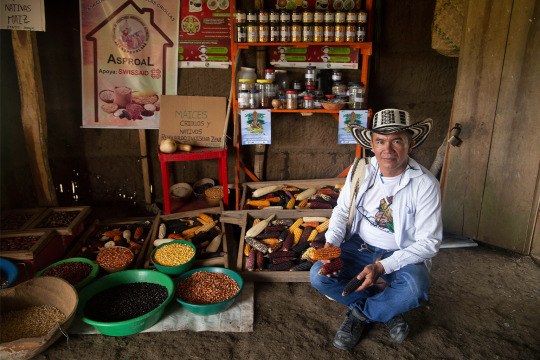
Pictured: Remberto Gil is a seed guardian and farmer who works at the Communitarian Seed House, where the ASPROL association stores 32 seeds of rare or almost extinct species. Image by Monica Pelliccia for Mongabay.
Located near Gil’s house, the seed bank hosts a rainbow of 12 corn varieties, from glistening black to blue to light pink to purple and even white. There are also jars of seeds for local varieties of beans, eggplants, pumpkins and aromatic herbs, some stored in refrigerators. All are ancient varieties shared between local families.
Outside the seed bank is a terrace where chickens and turkeys graze under an agroforestry system for farmers to emulate: local varieties of passion fruit, papaya and banana trees grow above bushes of ají peppers and beans. Traditional medicinal herbs like toronjil or lemon balm (Melissa officinalis) form part of the undergrowth.
Today, 25 families are involved in sharing, storing and commercializing the seeds of 32 rare or almost-extinct varieties.
“When I was a kid, my father brought me to the farm to participate in recovering the land,” says Nilvadys Arrieta, 56, a farmer member of ASPROAL. “Now, I still act with the same collective thinking that moves what we are doing.”
“Working together helps us to save, share more seeds, and sell at fair price [while] avoiding intermediaries and increasing families’ incomes,” Gil says. “Last year, we sold 8 million seeds to organic restaurants in Bogotà and Medellín.”
So far, the 80% of the farmers families living in the Zenù reserve participate in both the agroecology and seed revival projects, he adds."
-via Mongabay, February 6, 2024
#indigenous#ecology#agroforestry#agriculture#traditional food systems#traditional medicine#sustainable agriculture#zenu#indigenous peoples#farming#colombia#indigenous land#traditional knowledge#seeds#corn#sustainability#botany#plant biology#good news#hope#climate action#climate change#climate resilience#agroecology#food sovereignty
1K notes
·
View notes
Text
Science and activism can and should rely on each other
I identify as both a scientist and an activist. The creation of The Climate Conversations stems from a gap in the climate world, in which key scientific discussions never really leave the academy, and in turn the climate science space is not made accessible to activists. In sharing news, scientific breakthroughs (the good and the bad), adaptation and mitigation successes, and general climate knowledge, this community page strives to facilitate and support the conversation between scientists, activists, and anyone else who has an interest in our changing climate. Activists should utilize the climate data available in order to further their work; science can provide an even stronger foundation for justifying the climate fight and for combating misinformation. In order for this to occur, science should be made easily available to those outside the scientific community. Scientists should also listen to and keep up with activists as they develop their research, implement their methodologies, and share their results; without considering the social justice aspects and implications of their work, the data can only go so far in aiding communities impacted by climate change. As building solidarity between various social justice movements is a recognizable way to make them stronger, creating an interdisciplinary connection that transcends categorization (ie, within or outside academia) can also serve to mend theory with practice, bringing scientific studies into the realm of real life. An additional nuance that is important to take into account is the difference between the uses of Western science and traditional knowledge. The scientific method follows Western ideals, and Indigenous knowledge ends up forgotten and ignored. Western science can take a page from climate activist’s books by acknowledging and uplifting these traditional beliefs, wisdom, and ideas. Incorporating Indigenous perspectives when engaging with science and activism can provide richer and more nuanced outcomes and insights for the benefit of our planet, our environment, and our communities.
To close up these thoughts is an excerpt from Sherri Mitchell - Weh’na Ha’mu Kwasset’s essay Indigenous Prophecy and Mother Earth featured in All We Can Save: Truth, Courage, and Solutions for the Climate Crisis:
“Ironically, the Indigenous ways of knowing and being that European colonists saw as primitive and uncivilized are now being actively sought out to save our environment and humankind from the brink of extinction. Indigenous knowledge is based on millennia-long study of the complex relationships that exist among all systems within creation. It encompasses a broad array of scientific disciplines: ethnobotany, climatology, ecology, biology, archaeology, psychology, sociology, ethnomathematics, and religion. [...] Unfortunately, a great deal of critical Indigenous knowledge has remained outside the carefully ordered categorization of Western thought, making its holistic concepts difficult to comprehend for those who have been trained to see the world in fractured pieces. It is this fractured view that has been central to the fracturing of our societies and environment.”
#applications#applications in climate and society#science#activism#scienceandenvironment#climate activism#climate action#science and activism#traditional knowledge#indigenous knowledge#climate science#climate change#climate crisis#scientific method
0 notes
Text

Face Yoga and Traditional Beauty Culture Knowledge
This valuable chance awaits:
• anyone who cares about their beauty
• dedicated beauty care professionals and service providers
• anyone who wishes to maintain an ageless and youthful face
• anyone keen on managing mental and physical conditions such as stress, depression and issues with personality development
• anyone who wants to engage in occupations/ businesses with a positive mindset for success
Date: 03rd of January 2024
Time Duration: 10.00 am to 6.00pm
Dress code: Track Bottom and T-shirt
Should Bring: Your Personal Yoga Mat
Location: Faculty of Indigenous Social Sciences and Management Studies, Ambuldeniya, Nugegoda, Sri Lanka.
(https://maps.app.goo.gl/GHxxu4HDu7DthNTy8?g_st=iw)
Workshop Fee: 6000/=
Please make a deposit/ online bank transfer to the bank account mentioned below and upload a picture of your deposit slip/ online transaction receipt before the 28th of December 2023.
Bank Account Number (Course): 333-1-002-0- 0000059
Account Name: Gampaha Wickramarachchi University of Indigenous Medicine
Bank Name: People’s Bank
Branch Name: Yakkala
Registration Link:
https://forms.gle/tTc2MwEgDyrvgDfp6
Contact Us: +94770892796
0 notes
Text
Exploring the Multifaceted Realm of Knowledge
Knowledge is the cornerstone of human progress and understanding. It's the key that unlocks the doors to innovation, wisdom, and enlightenment. Yet, knowledge is far from being a one-size-fits-all concept; it comes in a variety of forms, each with its own unique characteristics and applications. In this exploration, we'll delve into the diverse landscape of knowledge, from its traditional definitions to its contemporary manifestations. We'll unravel the different types of knowledge and their significance in our quest for wisdom and enlightenment.
Knowledge can be categorized into various types based on its nature and how it is acquired. Here are some common types of knowledge:
Explicit Knowledge: This is formal and codified knowledge that is easy to communicate and share. It's typically found in documents, textbooks, databases, and other structured forms. For example, scientific principles or historical facts fall under explicit knowledge.
Tacit Knowledge: Tacit knowledge is more personal and difficult to formalize or articulate. It is often based on personal experience, insights, and intuition. Skills, expertise, and the "know-how" to do something are examples of tacit knowledge.
Procedural Knowledge: This type of knowledge relates to understanding how to perform specific tasks or procedures. It's often associated with practical skills and involves a sequence of steps or actions to achieve a particular goal. Cooking, driving, or playing a musical instrument are instances of procedural knowledge.
Declarative Knowledge: Declarative knowledge refers to factual information, concepts, and principles. It includes statements that can be "declared" or articulated. Knowledge about historical events, scientific theories, or mathematical formulas is declarative knowledge.
Prescriptive Knowledge: Prescriptive knowledge provides guidelines, recommendations, or rules for action. It suggests what should be done in a particular situation. For instance, medical guidelines for patient care or ethical principles can be considered prescriptive knowledge.
Situational Knowledge: This knowledge is context-specific and is relevant to particular situations or environments. It's often practical and helps individuals adapt to and make informed decisions in different scenarios.
Domain-Specific Knowledge: Domain-specific knowledge is specialized information in a particular field or domain. For example, a biologist's knowledge of specific biological processes is domain-specific.
General Knowledge: General knowledge encompasses a broad range of information that is not specialized in a specific domain. It includes commonly known facts, trivia, and basic awareness about various subjects.
Empirical Knowledge: Empirical knowledge is based on observation, experimentation, and evidence. It is often associated with scientific research and relies on the collection of data and empirical methods.
Cultural Knowledge: Cultural knowledge pertains to information about the customs, traditions, beliefs, and practices of a particular culture or society.
Anecdotal Knowledge: Anecdotal knowledge is based on personal anecdotes and stories. It may not be scientifically rigorous but can provide valuable insights based on individual experiences.
Innate Knowledge: Innate knowledge refers to knowledge that is believed to be inherently present within individuals, often suggested in philosophical discussions. It includes concepts like innate ideas or instincts.
Religious or Spiritual Knowledge: This type of knowledge involves beliefs, doctrines, and teachings associated with religious or spiritual traditions. It encompasses knowledge about the divine, morality, and the afterlife.
These are some of the many types of knowledge, and knowledge itself is a multifaceted and complex concept that can be further categorized or combined in various ways depending on the context.
#philosophy#epistemology#knowledge#learning#education#chatgpt#metaphysics#psychology#Knowledge Types#Forms of Knowledge#Traditional Knowledge#Contemporary Knowledge#Wisdom#Enlightenment
0 notes
Text
Nurturing Nature: Exploring Traditional Ecological Ways of Knowing During National Indigenous History Month

View On WordPress
#FriendsAreas#@FriendsAreas#community#culture#First Nations#Friends of the Saskatoon Afforestation Areas#George Genereux Urban REgional Park#History#Indigenous#Indigenous History Month#indigenous languages#indigenous rights#Indigenous Ways of Knowing#Richard St. Barbe Baker#Richard St. Barbe Baker AFforestation ARea#Saskatchewan#Saskatoon#traditional ecological knowing#traditional knowledge#TRADITIONAL WAYS OF KNOWING
0 notes
Text
Many of these aboriginal cosmologies, like that of the Amazonian Ufaina people referred to above, involve sophisticated conceptualizations of the flow of "life energy" that parallel contemporary environmental and economic theories, including Bataille's theory of General Economy.
"Biological Exuberance: Animal Homosexuality and Natural Diversity" - Bruce Bagemihl
#book quote#biological exuberance#bruce bagemihl#nonfiction#traditional knowledge#indigenous knowledge#amazonian#ufaina#sophisticated#conceptualization#life energy#environmental theory#economic theory#georges bataille#theory of general economy#cosmology
0 notes